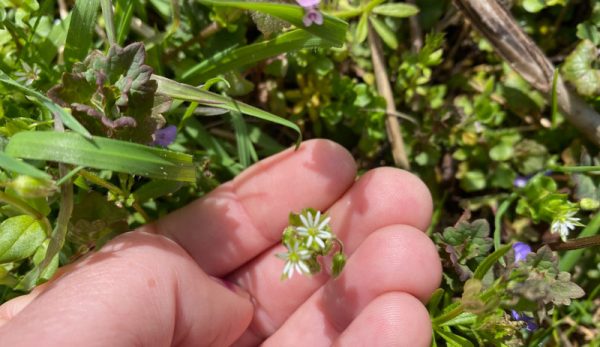
Chickweed might be the most universally tasty and versatile fresh wild edible that I know of. It’s the best for everyday eating—raw, by itself or as an addition to salad. It can be a spinach substitute for iron content in any soup or sauce recipe.
Chickweed also has helpful properties for healing skin. It has a drawing action when applied topically that can aid removal of foreign objects like splinters or an insect sting, or damaged tissue at risk of infection in a small irritable wound. When used as a fresh poultice it will take the heat out too. It will cool inflammation and soothe even the inner linings of the mouth, gums, esophagus and stomach as you eat it.
I also appreciate its high nutritive vitamin content and will dry the leaves for use as a powdered addition to soups and nutritive teas, as well as in topical solutions. It emerges early in spring and often appears to be crawling along the ground, though it can stand up leaning among grasses and other flowering creepers. Depending on moisture and sunlight, a chickweed plant could stay short, flower and go to seed within a matter of weeks.
So now (or when you find it) is the time to get it!
An On-the-Fly Poultice
To make a poultice on the fly in the field, grab a chewing gum-sized amount and chew it four to five times, then spit out a wad of plant (and spit). This green ooze can be placed right on the skin where the bug just bit or thorn just stabbed.
Once the hot, irritated feeling subsides and you start to feel relief, keep holding the homemade poultice to your bite while you shove another bit of fresh chickweed into your mouth. Keep the first poultice in place until the heat or irritability returns to your skin, wipe off the first and stick on the new one from your mouth.
Doing this as often as you need (or have patience for) will almost instantly relieve your irritation. You can pretty much guarantee that spot will not haunt you for days but be cleared up by evening or the next day.
Read more: Lamb’s quarters are a controversial forage find.
Identifying Chickweed
The Latin name, Stellaria media, is given for the star shape of its flowers, which are tiny (see reference pictures above and below). Some could flower earlier in a dry, sunny situation. Some may run along the ground, making longer stems and leaves, and seeming more succulent as they contain more water in their leaves and stems before they flower and go to seed.

Several species are known in the Stellaria family. Some are fuzzy, but the common chickweed’s smooth leaves are much more palatable to the tongue’s proclivities.
As always, find a knowledgeable person to help you identify it at first before harvesting.
The leaves are hard to distinguish from plenty of other diminutive spring wild flowers if you haven’t trained your eyes to their patterns. But in general look for a creeping mat; pull one stem, which should run along far from its central growth area with several other stems. These “clumps” form “mats” that form what seems like a carpet of chickweed from plant to plant.
And of course those white dainty flowers should be there. However it takes a close attention to the details of their petals and arrangement to tell the difference between them and, say, mustards!
Harvesting Chickweed
You can harvest the upper part of this plant any time. The tiny seeds are also edible, but quite crunchy. When drying I typically bundle them into a paper bag and, once the leaves have dried, I give them a shake. Most of the flowers and seed pods have matured to seed, which accumulates in the bottom of the bag.
Once I remove the green plant material, I can take that bag out and shake it over a patch of soil that might need something growing in it, or an area where I want the chickweed to compete so that I have more salad in the fall. It can easily sow itself.
If you don’t have chickweed in your front yard, you might easily find a gardener friend or neighbor who is happy for you to clear their garden beds around this time of year (also keep an eye out for ground ivy and cleavers). Chickweed likes moist mulch and rich garden soil, but the plant competes well even in a dry, shady location. It emerges early in spring and is opportunistic when flowering forbs have gone to seed or a garden has been put to bed for the fall.
The chickweed in my yard is frequently intermingled with Creeping Charlie, henbit and dead-nettle, making it easy for me to grab some scissors and harvest a wild salad.
I might hold a special place for chickweed because it was one of the first weeds I was able to eat wild in the gardens by the handful without too much of a hike. Its flavor is almost never bitter (like lettuce) and almost never astringent (like spinach). To me it seems like the perfect salad flavor.
After 20 years of foraging, I can still say I’m excited to find and eat some chickweed every single time.




